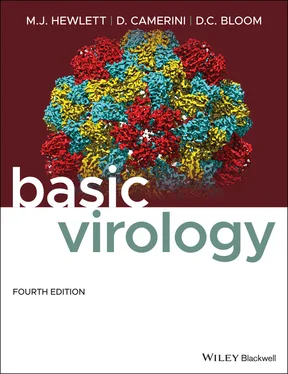Third, classifying viruses by the diseases they cause is not a particularly useful exercise when trying to understand relationships among viruses.
Fourth, and finally, viruses spread by very different routes can target the same organ. The movement of virus within the host is as important as the initial port of entry for the virus.
Viral infections of nerve tissue
The vertebrate nerve net can be readily divided into peripheral and central portions. The peripheral portion functions to move impulses to and from the brain through connecting circuits in the spinal cord. Viral infections of nerve tissue can be divided into infections of specific groups of neurons: neurons of the spinal cord ( myelitis), the covering of the brain ( meningitis), and neurons of the brain and brain stem itself ( encephalitis).
The brain and CNS have a privileged position in the body and are protected by a physical and physiological barrier from the rest of the body and potentially harmful circulating pathogens. This barrier, often referred to as the blood–brain barrier, serves as an effective but incomplete barrier to pathogens. Viruses that migrate through neurons can breach it and traverse synapses between peripheral and central neurons, by physical destruction of tissue due to an active infection, by direct invasion via olfactory neurons (which are not isolated from the CNS), or by other less well‐characterized mechanisms. Certainly, invasion of the CNS by pathogens is not all that rare since a specific set of cells in the CNS, the microglial cells, function in manners analogous or identical to macrophages in other tissues.
Many viruses can infect nerve tissue, and while some such infections are dead ends, other viruses specifically target nerve tissue. Viruses that do infect nerve tissue tend to favor one or another portion, and whereas the discrimination is not complete, many viruses, such as enterovirusesand genital HSV (HSV‐2), tend to be causative agents of meningitis; while others, such as rabies and facial HSV (HSV‐1), are almost always associated with encephalitis. Viral or aseptic meningitistends in general to be less life‐threatening than the majority of viral infections associated with encephalitis, but all are serious and can lead to debilitating diseases.
While many viral infections of the brain can have grave consequences, such consequences are not always the case. Some viral infections of the CNS have reasonably benign prognoses if proper symptomatic care is provided to the afflicted individual. Viruses that target the brain can be broken into several operational groupings, depending on the nature of brain involvement and whether it and associated tissue are a primary or secondary (“accidental”) target.
Examples of viral encephalitis with grave prognosis
Rabies
Once the symptoms of disease become apparent, rabies virus infections are almost always fatal. The virus targets salivary tissue in the head and neck in order to provide itself with an efficient medium for transmission to other animals. Involvement of the CNS and brain is eventually widespread, with ensuing neuronal dysfunction. Prior to this, however, the involvement is only with specific cells that lead to alterations in the afflicted animal's behavior and ability to deal with sensory stimuli. During this period, which is often preceded by a prodromalperiod of altered behavioral patterns, the animal can be induced to an aggressive biting frenzy by loud sounds or by the appearance of other animals. This course is the “furious form” of the disease. This behavioral change is most marked for carnivores such as dogs, cats, and raccoons, but can be observed in other infected animals such as squirrels and porcupines. The behavioral changes obviously have a marked impact on transmission of the virus, as the frenzied animal bite is often the instrument of spread.
Despite its association with frenzy (the name rabies is derived from the Sanskrit term for doing violence), not all rabies infections lead to the furious form. There is another form of the disease (often termed “dumb”) in which the afflicted animal becomes progressively more torpid and withdrawn, eventually lapsing into a coma and death.
The disease's long incubation period between the time of initial inoculation and final death is a very important factor, both in spread of the virus and in its being able to persist in wild populations, but there is also evidence that some animals can be carriers of the disease for long periods with no obvious, overt symptoms. While there are (extremely) rare examples of apparent recovery from the disease even after symptoms appear, generally one can consider the development of the symptoms of rabies as tantamount to a death sentence.
Encephalitis induced by HSV infection is the result of a physiological accident of some sort. Normally, HSV's involvement with neurons of the CNS and brain is highly restricted, although viral genomes can be detected at autopsy in brain neurons of humans who have died of other causes.
HSV encephalitis occurs only very rarely, but can be a result of either primary infection or an aberrant reactivation. Exactly what features of viral infection or reactivation lead to encephalitis are unknown, but a lack of effective immunity appears to be a major factor. Certainly, there is a much higher risk of invasive HSV encephalitis in neonates and infants with primary HSV infection prior to full development of their own immune defenses. If diagnosed during early clinical manifestations of disease, HSV encephalitis can be treated effectively with antiviral drugs (see Chapter 8, Part II). But within a short period of time (a few days at most), infection leads to massive necrotic destruction of brain tissue, coma, and death.
Although clinical isolates of HSV are often high in neurovirulence and neuroinvasive indices when they are tested in laboratory animals, there is no evidence that the virus recovered from patients with herpes encephalitis is any more virulent than those isolated from the more common, localized facial or genital infections. Moreover, there has never been any confirmed epidemiological pattern to the occurrence of herpes encephalitis that would suggest a specific strain of virus as a causative factor.
Viral encephalitis with favorable prognosis for recovery
Many of the viruses that cause encephalitis have RNA genomes and are carried by arthropod vectors from zoonoses, and human involvement is often incidental. Such viruses are often termed arboviruses, although this is an imprecise classification that includes two groups of viruses not closely related by other criteria.
The symptoms of encephalitis in wild animals can be difficult to measure, but several equine encephalitis viruses are known to cause serious disease in horses. Often the symptoms of viral encephalitis in humans are drowsiness, mild malaise, and sometimes coma. These mosquito‐borne encephalitis viruses do not usually directly invade neural tissue itself, but rather infect supporting tissue. The host response to this infection and resulting inflammation lead to the observed neurological symptoms.
Since tissue at the periphery of neural tissue is the primary target for such encephalitis virus infections, the infection can be resolved and complete recovery will ensue, provided that the host's immune defenses work properly. During the disease's symptomatic period, lethargy and malaise of infected individuals make them vulnerable to other environmental hazards, including infection with other pathogens. But provided these risks are avoided by means of proper care, the disease generally resolves.
Читать дальше












